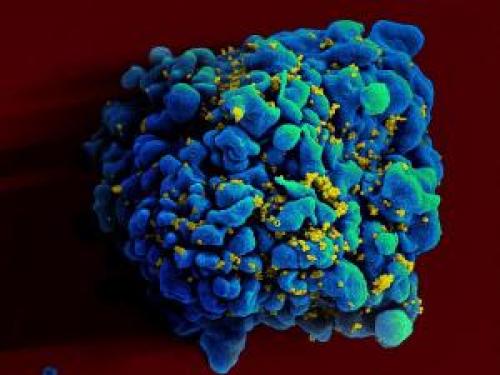Experimental mRNA HIV vaccine safe, shows promise in animals
NIH scientists developed vaccine platform.
An experimental HIV vaccine based on mRNA—the same platform technology used in two highly effective COVID-19 vaccines—shows promise in mice and non-human primates, according to scientists at the National Institute of Allergy and Infectious Diseases (NIAID), part of the National Institutes of Health. Their results show that the novel vaccine was safe and prompted desired antibody and cellular immune responses against an HIV-like virus. Rhesus macaques receiving a priming vaccine followed by multiple booster inoculations had a 79% lower per-exposure risk of infection by simian-human immunodeficiency virus (SHIV) compared to unvaccinated animals.

Scanning electromicrograph of an HIV-infected H9 T cell. NIAID
“Despite nearly four decades of effort by the global research community, an effective vaccine to prevent HIV remains an elusive goal,” said NIAID Director Anthony S. Fauci, M.D., chief of the Laboratory and a paper co-author. “This experimental mRNA vaccine combines several features that may overcome shortcomings of other experimental HIV vaccines and thus represents a promising approach.”
The experimental vaccine works like mRNA COVID-19 vaccines. However, instead of carrying mRNA instructions for the coronavirus spike protein, the vaccine delivers coded instructions for making two key HIV proteins, Env and Gag. Muscle cells in an inoculated animal assemble these two proteins to produce virus-like particles (VLPs) studded with numerous copies of Env on their surface. Although they cannot cause infection or disease because they lack the complete genetic code of HIV, these VLPs match whole, infectious HIV in terms of stimulating suitable immune responses.
In studies with mice, two injections of the VLP-forming mRNA vaccine induced neutralizing antibodies in all animals, the investigators report. The Env proteins produced in the mice from the mRNA instructions closely resembled those in the whole virus, an improvement over previous experimental HIV vaccines. “The display of multiple copies of authentic HIV envelope protein on each VLP is one of the special features of our platform that closely mimics natural infection and may have played a role in eliciting the desired immune responses,” said Dr. Lusso.
“We are now refining our vaccine protocol to improve the quality and quantity of the VLPs produced. This may further increase vaccine efficacy and thus lower the number of prime and boost inoculations needed to produce a robust immune response. If confirmed safe and effective, we plan to conduct a Phase 1 trial of this vaccine platform in healthy adult volunteers,” said Dr. Lusso.
Source: U.S. National Institutes of Health
- 475 reads
Human Rights
Fostering a More Humane World: The 28th Eurasian Economic Summi

Conscience, Hope, and Action: Keys to Global Peace and Sustainability

Ringing FOWPAL’s Peace Bell for the World:Nobel Peace Prize Laureates’ Visions and Actions

Protecting the World’s Cultural Diversity for a Sustainable Future

Puppet Show I International Friendship Day 2020

